Australian Bernedoodles Puppy and Australian Bernedoodle Breed
The Australian Bernedoodle, a beloved doodle breed, is gaining popularity due to its affectionate nature and unique characteristics. This article aims to provide comprehensive information about the Australian Bernedoodle, including its origin, breed description, temperament, care requirements, and suitability as a family pet.
The Australian Bernedoodle is a charming mix of the Poodle, Bernese Mountain Dog, and Australian Labradoodle. These intelligent and friendly Bernedoodle pups make great additions to families, even those with kids or other pets.
It’s important to note that these pups need regular exercise and mental stimulation to stay happy and healthy. Featuring varied wavy coat colors and types, Australian Bernedoodles require steady grooming.
Owners can expect these Bernedoodle puppies to have a 12 to 15-year lifespan, depending largely on their genetic makeup and the quality of care they receive.
Key Takeaways
- Australian Bernedoodles blend Poodle, Bernese, and Labradoodle traits.
- They thrive on exercise and mental challenges.
- Proper care can lead to a 12 to 15-year lifespan.
Quick Facts
The Australian Bernedoodle, a popular doodle hybrid breed, is perfect as a family dog, especially for individuals with allergies due to its minimal shedding coat. Known for their friendly and balanced nature, these dogs combine the smarts of a poodle with the loyalty of a Bernese Mountain Dog.
These pups are calm, friendly, and thrive when integrated into family activities. To tap into their intelligence, it’s important to note that it’s beneficial to begin training these Bernedoodle puppies using positive reinforcement techniques from a young age. Even though they have a reasonably laid-back energy level, Australian Bernedoodles still need regular mental and physical activity—aim for daily walks or playtime lasting around 30 to 40 minutes.
Australian Bernedoodle Pictures
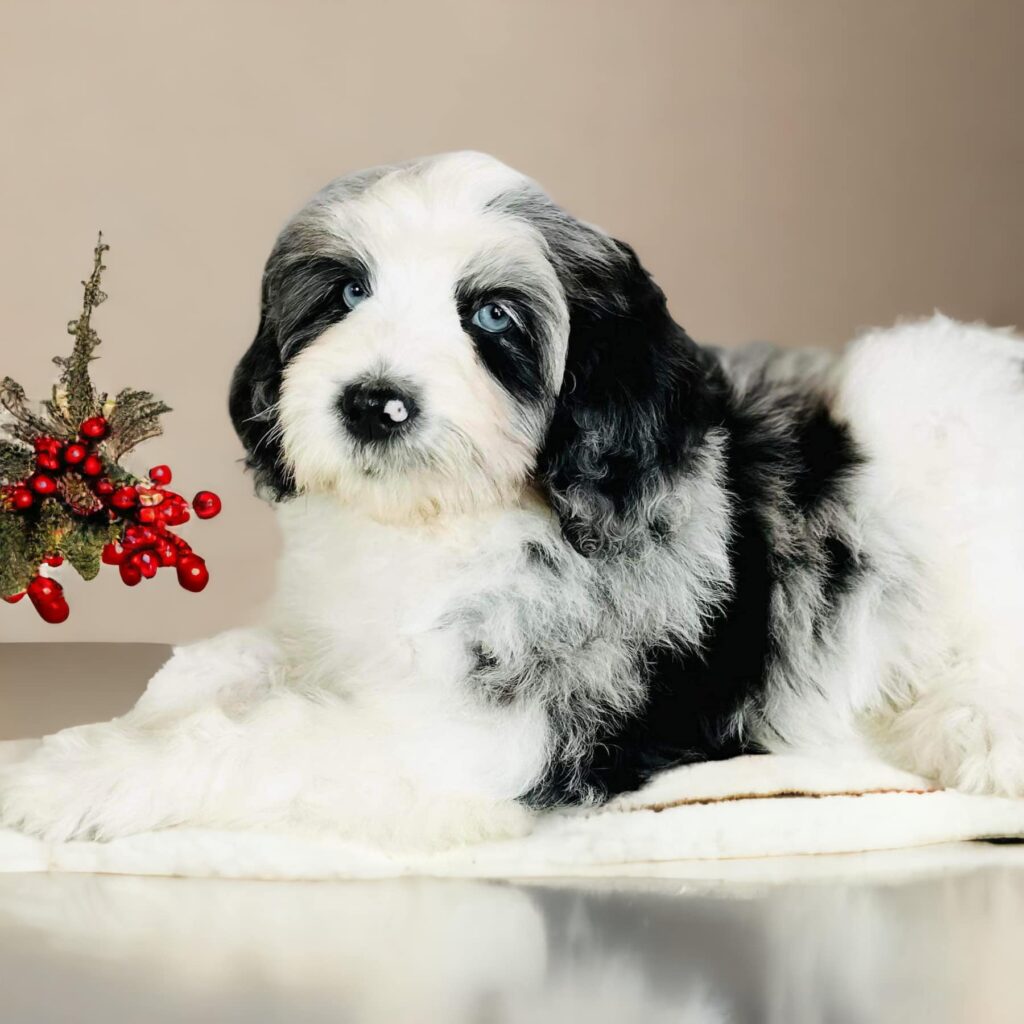
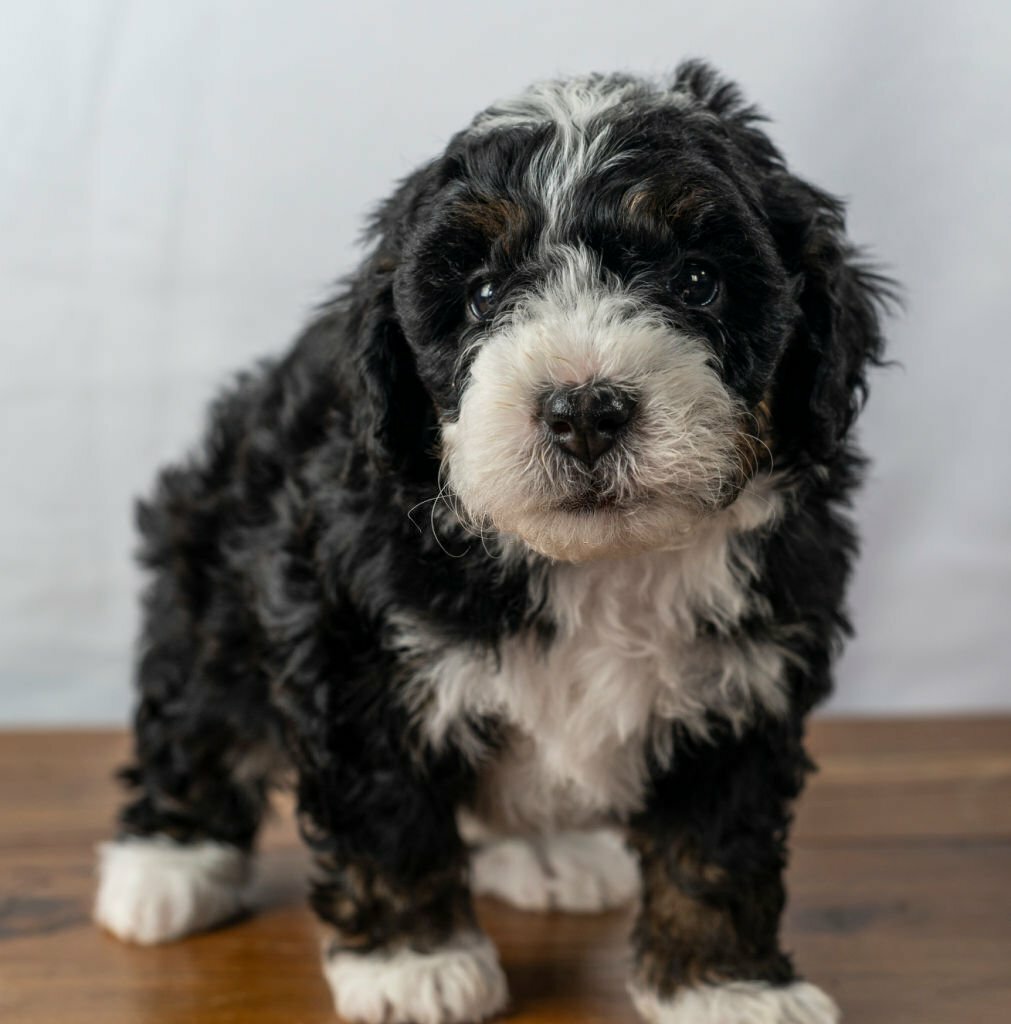
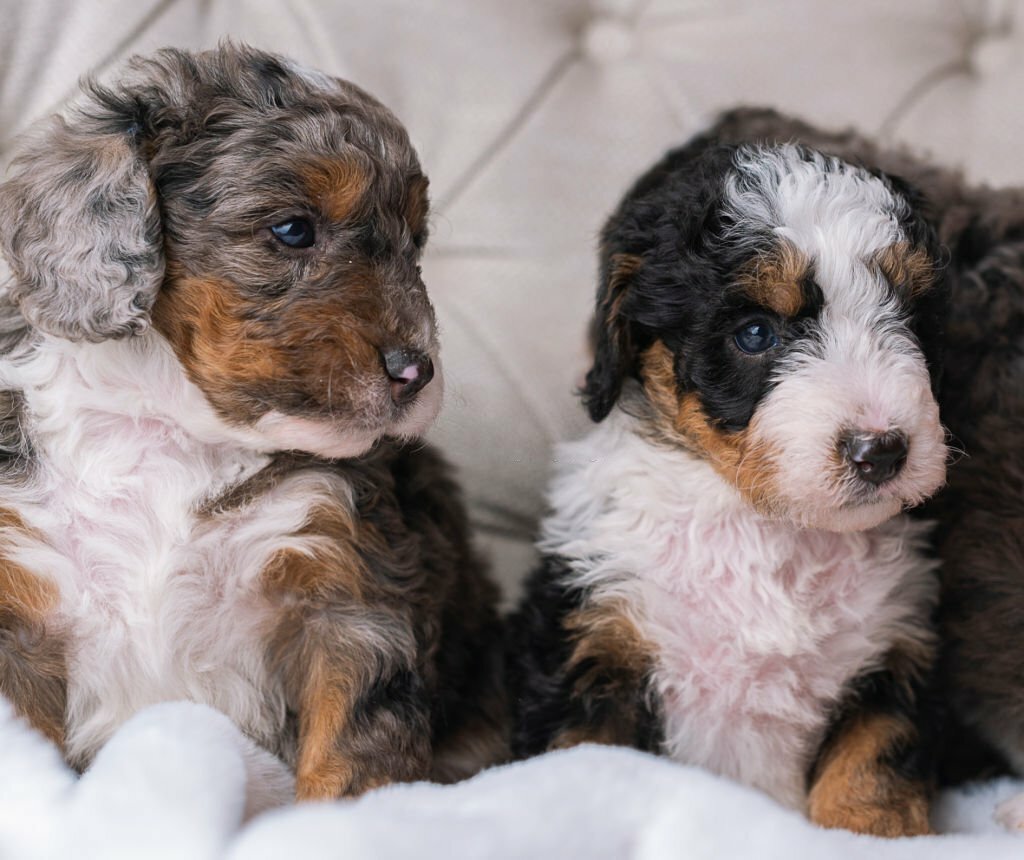
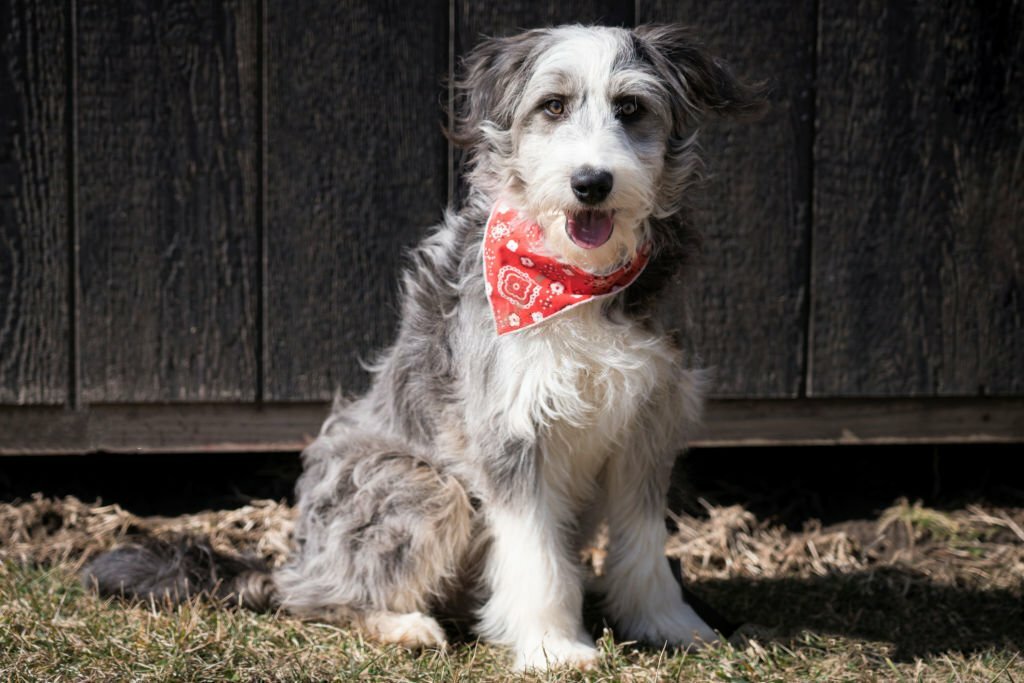
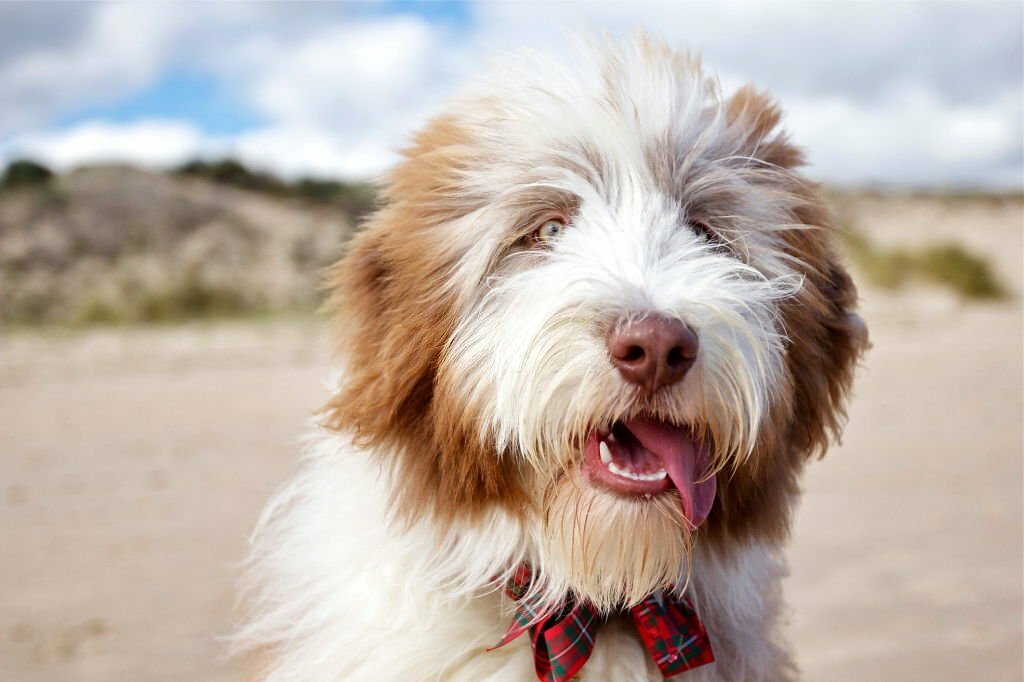
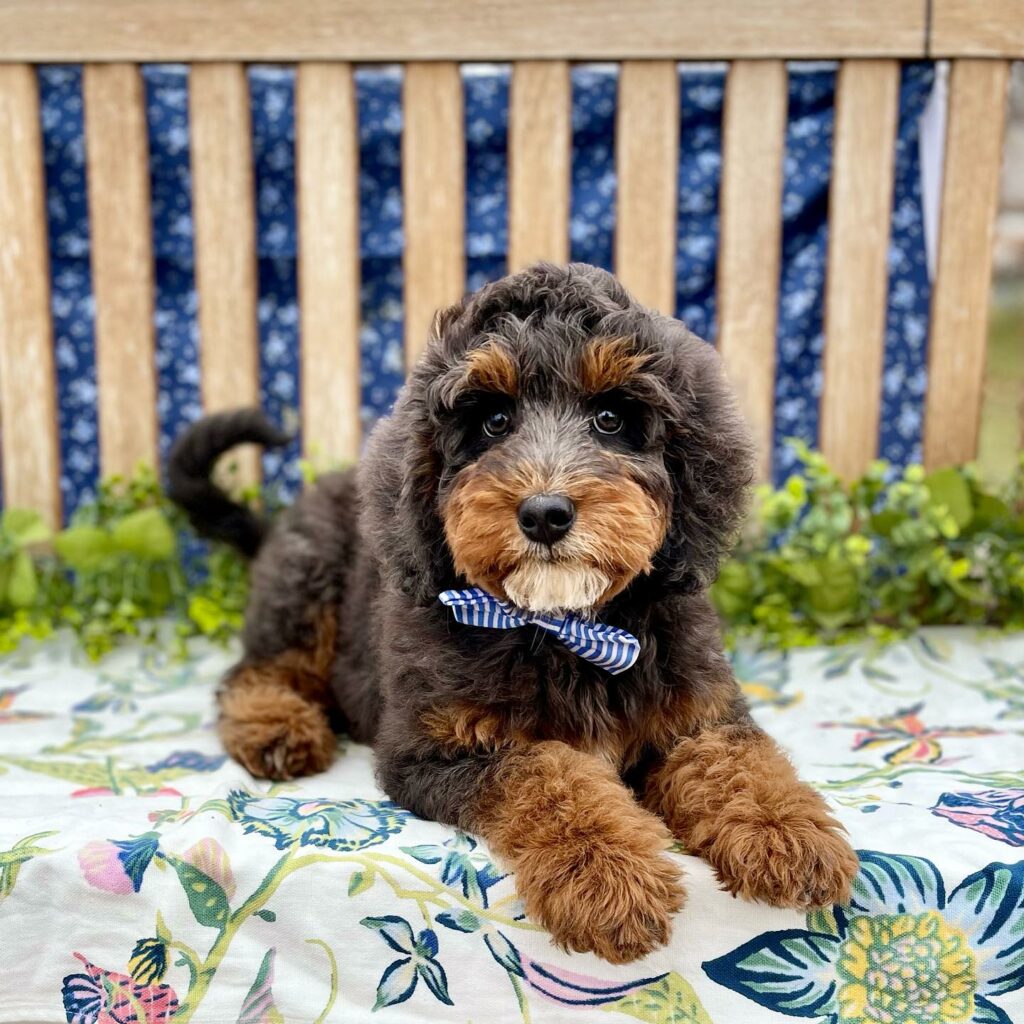
Overview
The Australian Bernedoodle is a cross between the Bernedoodle and the Australian Labradoodle, gaining popularity for its intelligent, friendly, and allergy-friendly coat. These dogs combine the best of their parent breeds, making them sharp and sociable pets.
They have moderate energy levels and thrive on mental stimulation and physical exercise. Early training is crucial for their development, and thanks to their pleasant and cooperative nature, they fit nicely into various family settings.
Breed Key Features
The Australian Bernedoodle stands out in dog breeding with its unique mix, which includes traits from the F1 Bernedoodle and the multigene Australian Labradoodle. This mix creates a dog that’s not only smart but also has a calm and friendly nature. The Australian Bernedoodle is crafted to bring out the best in its appearance and personality, making it a loving pet for many types of homes.
| Feature | Description | Emotional Appeal |
|---|---|---|
| Lineage | Mix of F1 Bernedoodle and Multigen Australian Labradoodle | Appreciation for distinct and refined breed qualities |
| Intelligence Level | Advanced thinking skills | Enjoyment of intelligent company |
| Temperament | Stable and good-natured | Contentment with a dependable and kind pet |
The Australian Bernedoodle’s heritage gives it a sense of rarity and excellence, making it a prized choice for dog enthusiasts. Their intelligence means they learn quickly and can be great partners in various activities. Their temperament ensures they are consistently pleasant companions, offering peace of mind to families and individuals seeking a gentle dog.
Breed Origins of Australian Bernedoodles

The Australian Bernedoodle is a unique blend of the Bernese Mountain Dog and the Australian Labradoodle. The latter breed combines the best of the Labrador Retriever, Poodle, and Cocker Spaniel. This mix is designed to bring together the best qualities of these dogs, such as improved health and a calm demeanor, through the benefit of crossbreeding.
Records of the breed’s development show a clear lineage and highlight the steps taken to establish the Australian Bernedoodle. The heritage includes:
- Parent Breeds: Bernese Mountain Dog, Poodle, Labrador Retriever, Cocker Spaniel
- Crossbreeding Advantages: Better health, calmer temperaments, more genetic variety
- Developmental History: Notable dates and the people who played a role in the breed’s origin
- Consistency Efforts: The work done to keep the breed’s characteristics stable
These details give us insight into the Australian Bernedoodle’s past and the efforts to maintain its quality.
Parent Breeds Heritage
To fully appreciate the Australian Bernedoodle, knowing its parentage is essential. This includes Switzerland’s sturdy, serene Bernese Mountain Dog and the Australian Labradoodle. The latter mixes the Labrador Retriever, Poodle, and Cocker Spaniel breeds.
The Bernese Mountain Dog contributes its well-built frame and distinctive tri-color coat to the Australian Bernedoodle. It’s also recognized for its tranquil nature. Breeders focus on the health of this dog to reduce inherited health issues.
The Australian Labradoodle was carefully bred to combine the best traits of its ancestors. This includes a hypoallergenic coat and a consistent personality. Adding Cocker Spaniel genes helps to control the size and boost overall health. The result is an intelligent and affectionate pet. These dogs are known for their friendly and predictable behavior.
Hybrid Vigor Benefits
The Australian Bernedoodle is a mix of a Bernese Mountain Dog and an Australian Labradoodle, specifically bred to reduce health problems often seen in purebreds. This mixed breed draws from a diverse genetic pool, which helps lessen the chances of inheriting specific diseases from its parent breeds.
These dogs tend to be more robust and full of life, a clear benefit of the hybrid vigor phenomenon. As a result, Australian Bernedoodles generally enjoy better health than many purebred dogs, demonstrating the successful combination of their parents’ best qualities while minimizing health risks.
Historical Development Timeline
In the early 2000s, the Australian Bernedoodle began its journey when Sherry Rupke of SwissRidge Kennels crossed a Bernese Mountain Dog with an Australian Labradoodle. The goal was to combine the best qualities of these breeds, resulting in a dog that is both intelligent and friendly with a coat that is less likely to shed.
Being a mix of several generations, the Australian Labradoodle brought consistency in coat texture and increased genetic diversity.
Over time, breeders have focused on creating a consistent Australian Bernedoodle, known for its predictable personality and appearance. This dedication to selective breeding has made the Australian Bernedoodle a sought-after pet for families and individuals.
Weight and Height Range

Australian Bernedoodles come in a wide range of sizes, mainly due to whether they’re a standard or a miniature variety. The genes they inherit from their Bernese Mountain Dog and Poodle parents greatly determine their growth and ultimate size.
Knowing how a dog’s height relates to its weight helps owners monitor their pet’s health and growth effectively.
The average adult size of a Bernedoodle can vary quite a bit. Growth rates also differ from one dog to the next. The distinction between a mini and a standard Bernedoodle is more than just size; it can influence lifestyle needs and space requirements for families considering adopting one.
Understanding the proper height-to-weight ratio ensures these charming dogs stay healthy and thrive.
Average Adult Size
Australian Bernedoodles come in a wide variety of sizes. The larger ones can grow to 23 to 29 inches and weigh from 50 to 90 pounds, while the smaller miniatures range from 18 to 22 inches tall, weighing 25 to 49 pounds.
Due to their size, Standard Bernedoodles need regular exercise to stay healthy and manage their energy. They inherit strength and agility from their Poodle and Bernese Mountain Dog parents, so they require workouts that meet their energetic and mental needs.
If you’re thinking of getting one, be ready to engage in daily activities that suit their specific size needs, striking a balance between activity and rest for their overall well-being.
Growth Rate Variations
Understanding how Australian Bernedoodles grow is essential because their sizes vary significantly as they age. The size of a Bernedoodle depends on its parents and whether they’re a standard or a miniature version.
A full-grown standard Australian Bernedoodle can be between 23 and 29 inches tall at the shoulder and weigh between 50 and 90 pounds. On the other hand, a miniature Australian Bernedoodle might only grow to 18 to 22 inches tall and weigh 25 to 49 pounds.
Knowing these growth rate variations is vital for providing the proper care, including the right food and exercise, which helps keep them healthy.
Mini Vs. Standard
When looking at the two sizes of Australian Bernedoodles, it’s clear that standard Bernedoodles are large, measuring between 23 and 29 inches tall and weighing 50 to 90 pounds.
Miniature Bernedoodles, on the other hand, are smaller, with a height of 18 to 22 inches and a weight range of 25 to 49 pounds.
The Bernedoodle’s coat, a unique combination of Poodle and Bernese Mountain Dog hair, can vary in thickness and curl, but these differences are usually minor between the sizes.
Considering activity levels, both sizes are lively, but the bigger standard Bernedoodle may need more room to move around and regular exercise to stay healthy and prevent issues like hip dysplasia, a hereditary condition that can worsen with poor weight management.
Height-To-Weight Proportion
Australian Bernedoodles are known for their balanced build, with standards standing between 23 and 29 inches and weighing 50 to 90 pounds. Miniature versions are shorter, ranging from 18 to 22 inches, and lighter, weighing about 25 to 49 pounds.
Maintaining this balance is critical for Bernedoodles’ health. Owners should closely monitor their dog’s growth to catch any signs of health issues early.
A Bernedoodle in good shape displays a muscular build and a zest for life, which is natural for this active breed.
Breed Size Genetics
The size and weight of Australian Bernedoodles owe a lot to their genetic heritage, but the breeders’ skills also shape these dogs’ physical characteristics. Breeders carefully mate Bernese Mountain Dogs with Australian Shepherds to create a dog that is both sturdy and agile, with a size that can adapt to various living situations.
Miniature Australian Bernedoodles are smaller, usually measuring 18 to 22 inches tall and weighing around 25 to 49 pounds. On the other hand, the standard-sized ones are bigger, growing to 23 to 29 inches in height and tipping the scales at 50 to 90 pounds.
These hybrid dogs display a well-balanced figure, a testament to the intentional mixing of their parent breeds’ best features.
Temperament Traits
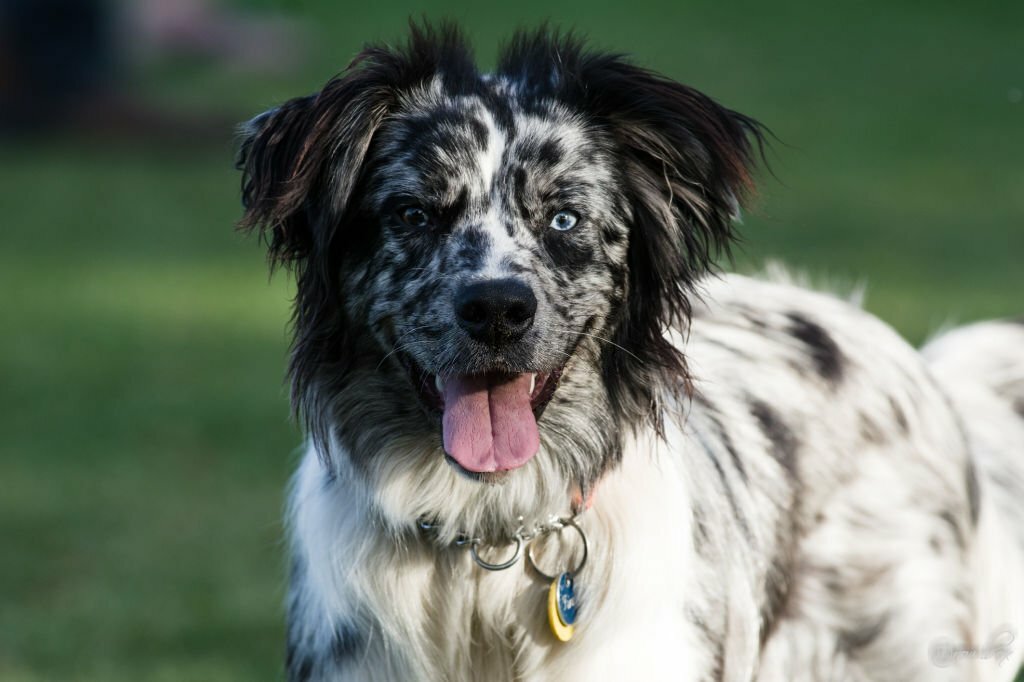
The Australian Bernedoodle combines the traits of its Australian Labradoodle and Bernese Mountain Dog ancestors. Known for their ability to adapt and social nature, these dogs fit well into various home environments. Their intelligence and affection make them great partners for their human families. They show warmth and loyalty to their owners and often have a balanced temperament.
Individual Australian Bernedoodles might be cautious around new people, which can differ from one dog to another. They are also quick learners, keen to please, which makes them highly trainable. This breed’s smartness and desire to learn contribute to their reputation as excellent pets.
Affectionate Family Companions
Australian Bernedoodles are known for their loyal and loving personalities, making them perfect family companions. They are a mix of attributes, combining intelligence and kind nature with a fun-loving spirit that endears them to people of all ages.
These dogs thrive in diverse family settings due to their eagerness to please, making them responsive to training with positive rewards. Australian Bernedoodles are exceptionally patient and caring with kids, which helps them form protective and entertaining relationships. Still, watching over playtime between the dog and young children is wise to keep everyone safe.
General Behavioral Tendencies
Australian Bernedoodles are a friendly and balanced mix, inheriting the best traits from their parent breeds. They are intelligent and close, making them great pets for families and individuals. These dogs learn quickly and respond well to training, enjoying the mental stimulation of learning new commands.
They are also very playful and love interacting with people, which makes them perfect playmates for kids. However, supervising their play is always a good idea to ensure everyone has fun safely.
Australian Bernedoodles need regular exercise and mental stimulation to keep them happy and healthy.
Reaction to Strangers
Australian Bernedoodles are known for their welcoming attitude toward strangers, reflecting the friendly qualities of their Bernese Mountain Dog and Poodle ancestors. Early socialization is critical for these dogs to grow confident and well-behaved around new people.
Positive training methods are crucial in shaping their friendly behavior and encouraging them to respond well in different social settings. Encouraging interactions with various people and other dogs helps them develop into well-mannered adults.
With their natural intelligence and ability to adjust, Australian Bernedoodles can become ideal companions for those who enjoy an active social life.
Playfulness and Energy Levels
The Australian Bernedoodle is known for being playful and has a good amount of energy, making a mix of exercise and brain games necessary for their happiness. Although they can be relaxed, these dogs often show their zest for life with sudden lively moments.
Owners of Australian Bernedoodles should plan for daily activities that keep their legs moving and their minds busy, as this breed loves a challenge and thrives on interaction. Various physical and mental exercises are crucial to shaping their pleasant nature.
People thinking about getting one of these dogs should be ready to create a supportive setting where these characteristics can flourish.
Trainability and Intelligence
Australian Bernedoodles are intelligent and naturally willing to please, making them quite trainable. They grasp new commands quickly and are known for their ability to follow instructions with ease. Starting their training early is critical, and it’s vital to be patient and consistent to tap into their full capabilities.
These dogs quickly pick up on training cues, which can be an excellent advantage for first-time dog owners. The gentle nature they inherit from their parent breeds creates an ideal setting for learning that flourishes with positive feedback. Bernedoodles are versatile in different training styles but mainly thrive with methods that balance kindness and discipline.
Their zest for learning and friendly disposition make training them a fulfilling endeavor.
Health Concerns & Lifespan
Australian Bernedoodles, like all breeds, can inherit certain health conditions that may affect their quality of life and how long they live. These dogs can expect to live between 12 and 15 years on average. Being proactive with their health is vital to help them live longer and healthier lives.
Regular check-ups with a vet are essential for catching and managing illnesses early on.
Common genetic disorders can impact these dogs, so being aware of them is essential for any owner. Knowing the expected lifespan of the breed helps in understanding what to expect and how to plan for their care.
Preventive health measures, such as vaccinations and regular screenings, are powerful tools for preventing diseases before they become serious. Early veterinary care is crucial for managing health issues effectively, potentially extending your dog’s life.
Common Health Issues
Understanding the health issues that Australian Bernedoodles might face is vital for anyone considering this breed. They can live between 12 to 15 years with the proper care. Crossbreeding may reduce some health issues, but Australian Bernedoodles can still be prone to certain genetic conditions. Good breeders screen for these issues to reduce the chance of disease in puppies.
To keep Australian Bernedoodles healthy, they need a balanced diet and plenty of physical and mental exercise due to their energetic nature and size. Regular grooming is crucial, too, as it prevents skin problems from an unmanaged coat. Proper care can lead to a happy and long life for your pet.
Average Lifespan Expectancy
Australian Bernedoodles generally have a lifespan of 12 to 15 years. Their health and longevity are closely linked to proper care, including consistent vet visits and preventive actions against genetic issues.
These mixed-breed dogs often have more robust health due to their mixed genetics, which can lead to a lower chance of inheriting certain conditions. Yet, a balanced diet that meets their unique nutritional requirements is critical to their well-being. It’s essential to control their food portions to avoid obesity, which can lead to other health problems.
Regular physical activity is just as essential to keep them in good shape. Following these care recommendations is critical to helping your Bernedoodle live a whole life.
Preventative Care Importance
For Australian Bernedoodles, proactive health management is critical to reducing the risk of hereditary diseases and ensuring a longer, happier life. Understanding the necessity of preventative care is a step towards a healthier life for these energetic dogs.
Frequent vet check-ups are fundamental for spotting and treating inheritable health issues early.
A diet designed for an active, large breed helps maintain a healthy weight and avoid complications that arise from obesity.
Daily exercise is good for their body and stimulates their mind, essential for their overall well-being.
Regular grooming of their thick fur is imperative to avoid tangles and skin problems.
These aspects of care are the building blocks to a vibrant and extended life for an Australian Bernedoodle.

